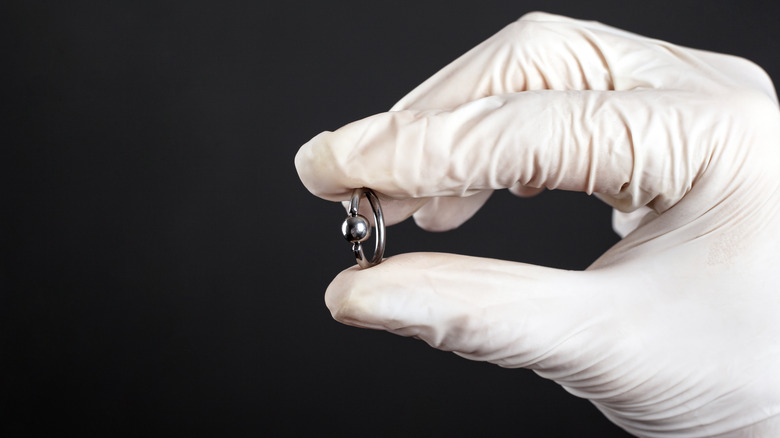The Truth About Lip Gauges
When you think about piercings, your mind probably envisions something you can get from your local mall's Claire's store or Piercing Pagoda. To date, the most popular piercings in the U.S. include industrial piercings, nose piercings, conch piercings, cartilage piercings, nipple piercings, rook piercings, belly button piercings, and tongue piercings (via Rebels Market). You hear less about the more uncommon piercings, such as dermal and micro-dermal piercings, corset piercings, and bridge piercings (via Painful Pleasures). In fact, these are so rare that you may have never heard of them.
Lip piercings, on the other hand, are somewhere in the middle. Some single lip piercings — like the Monroe, Medusa, Ashley, or Labret — are more common than others (via Fresh Trends). There are even select double and quadruple lip piercings that you've probably seen displayed before, such as snake bites.
However, there are still others that haven't made their way to the West and largely exist solely in indigenous African cultures. One such piercing is the lip gauge, which is often referred to as the lip plate. If you're curious about this extremely rare form of body modification, read on.
What is a lip gauge, and how exactly does it work?
First things first: What even is a lip gauge? Well, according to Byrdie, the term "gauge" in the piercing world simply refers to how thick or wide the shaft of a piece of jewelry is. In other words, a gauge size determines how big the hole in your skin has to be to accommodate the jewelry. However, people often think of gauges as piercings that have thicker than normal shafts.
Whereas a standard ear or nose piercing is an 18 gauge (or 0.04 inches), for larger gauges, "the smallest gauge usually starts at size 8 and goes up from there," says Brian Keith Thompson, the Chief Piercing Officer at Body Electric Tattoo in Los Angeles (via Byrdie). An 8 gauge is one-eighth of an inch, as the gauge sizes work in reverse — i.e., the smaller the gauge number, the bigger the piercing.
If you want a large lip gauge, you typically get pierced with the standard size and then go through a process called stretching. Increasing your gauge size must be done gradually and carefully, lest you risk tearing or scarring. Our Everyday Life suggests multiplying the time it took for you to heal from your initial piercing by three to find the amount of time you should wait between stretches. So if it took 12 weeks for your lip piercing to heal, you should ideally wait another 9 months before putting in a larger piece of jewelry.
What are the differences between lip gauges and lip plating?
As mentioned, lip gauges in the U.S. are quite rare. However, they are commonplace in some African cultures — they just go by a different name: lip plating. The two are essentially the same thing, but while the former refers to a type of piercing, the latter more so refers to a cultural practice.
According to Medical Bag, lip plating is a form of body modification that's practiced by several indigenous tribes, mostly in the central and southern parts of Africa. Women belonging to the Mursi tribe in Ethiopia famously partake in the tradition, which draws Western tourists into their village out of curiosity.
Although the methods and rituals surrounding lip plating vary from tribe to tribe, "most tribes consider an enormous lip plate a traditional sign of beauty," per Medical Bag. Typically, lip plates are constructed out of wood or clay, and they symbolize social or sexual maturity. In Mursi culture, there's often a large feast to commemorate the day a girl gets her initial piercing (usually around the age of 16). The swift stretching process lasts around a year and ends with a gauge that's just over 4 inches wide.
According to Tat Ring, there is increasing pressure from the Ethiopian government to give up lip plating, and more and more women from the Mursi tribe are opting out of the practice due to the pain involved. For now, though, it's still a fairly common occurrence.


